The All-Star treatment
Super Mario Bros. doesn't have nearly as many changes as Super Mario Bros. 3, so let's take a closer look at some of the graphical enhancements.
Most likely the first thing you'll notice is that Super Mario All-Stars has a variety of backgrounds with parallax scrolling. Things like bushes and fences stayed in front, while hills and clouds were moved to a parallax layer. All blocks look more 3-D, and the ground no longer looks like it's made up of separate blocks.
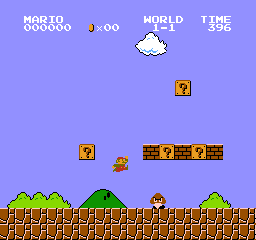
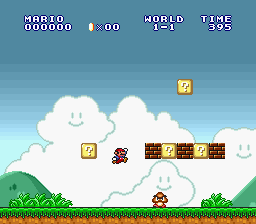
Water stages' backgrounds have a nice wavy distortion effect. Also notice the enemy color changes...


Night levels have colorful, twinkling stars in the background. Worlds 5-1 and 7-1 also have snow-covered ground similar to 3-1.
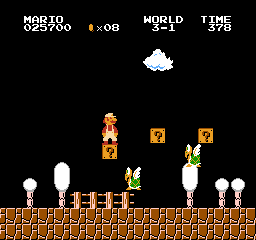
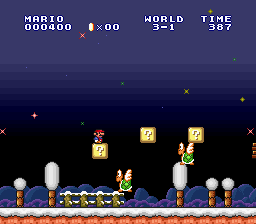
Underground levels are a little brighter.


This new background accompanies the two areas with spotted mushroom platforms.


The Bros.
Luigi is no longer just a palette swap of Mario, and appears taller and skinnier than his brother. Wearing a green shirt, Fiery Luigi is now colored differently from Fiery Mario. Also, the Bros. have a different standing pose and wear white gloves in SMAS.




Enemies
Bloopers were changed from white to pink.
![]()
![]()
The slow Cheep-Cheeps were changed from gray to green.
![]()
![]()
Bullet Bills have animated arms.
![]()
![]()
Bowser looks more like his SMB3 design.


Podoboos shoot up about three blocks higher in SMAS, where they usually reach the status bar. This gives Mario more time to pass under them.
Audio
In the SMAS version:
- Maze levels 4-4, 7-4, and 8-4 have audio cues at key points to let you know whether or not you took the correct path.
- Sound effects were added for spring boards, Podoboos shooting out of lava, and enemies' hammers.
- New background music is used for underground/cloud bonus areas.
- Consecutive shell hits increase in pitch until a 1-Up is attained.
- Underground music uses the SMB3 remix style.
- Mario's jump sound effect does not change with his size.
- There is new background music for Bowser battles.
- Sound effects echo underground.
Multi-player
In the SMAS version:
- Players also switch turns after level completion in 2-P mode, instead of only after each death.
- You can't pause with controller one when player two is playing.
Title screen
On the title screen, the copyright dates were updated, and a trademark symbol was added after the title. Whereas the NES version had no background music at all here, SMAS has a remix of the SMB water theme. The title logo block was moved down a little, opening up some space between it and the info at the top of the screen.

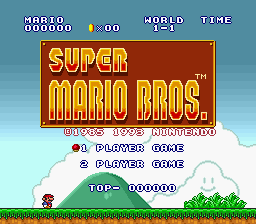
Saving
Like the other games in SMAS, SMB has four save slots. The number of players chosen at the title screen is also saved along with your game.

When loading saved games, the other player option is missing.
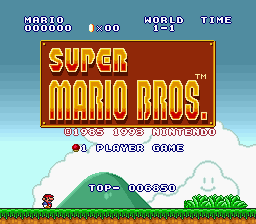

Of course, the original SMB has no save feature. SMAS lets you save anytime via the new pause menu, but you'll start back at the very beginning of the world. For example, if you save and quit during 4-4, you'll resume your game in 4-1. You will also have a chance to save on the game over screen.
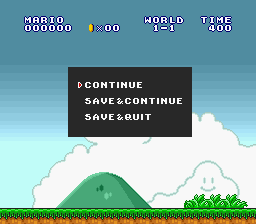
Another advantage of having battery backup, the "TOP" score is now saved in SMAS.
Unlimited continues and a save feature render the original game's continue code (hold A and press Start at the title screen) obsolete.
Lives
You start off with two more lives in SMAS.


SMAS shows double-digit extra lives correctly. The original SMB pulled symbols from its second CHR table once the extra life total surpassed nine.

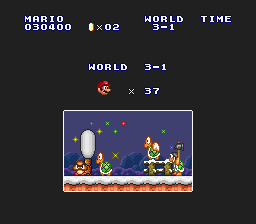
Level intro screen
The SMAS level intro screen gives a brief preview of the level setting, including the enemies Mario will face.


Level ending
The flags at the goal area were animated for SMAS. The skull flag's colors were inverted, and it now flies in the same direction as the castle flag. The castle flag's star was changed from red to green.


Mario faces us and flashes his signature V-sign before entering the castles behind flagpoles.

Yellow flags were added to the big castles seen at the end of x-3 worlds and at the beginning of the next x-1 worlds. In the NES version, the castle wall continues off screen to the right. In SMAS, Mario enters the second door of the large castle instead of the first.


In SMAS, the end-of-level time bonus is now awarded in x-4 levels, allowing for much higher scores.
Mushroom Retainers
In SMAS, the Mushroom Retainers escape from tied bags and have different actions for each world. For example, in World 5-4, five Mushroom Retainers roll out of the bag and end up sitting in a circle, dizzy from the escape. Usually, the number of Mushroom Retainers that pop out matches the world number.


Notices
SMAS's "time up" screen has a nice picture of the brother you're using, as well as a small "Super Mario Bros." logo.


SMAS's "game over" screen has the same images as the "time up" screen.


Bonus areas
In SMAS, the bonus rooms have a background graphic of Mario giving you a V-sign.


If you're player 2, a Luigi image will appear instead.

Coin Heaven
"Coin Heaven" also has the Bonus background image. The moving white platform was changed to a smiling cloud.


Lava
Some lava pits in the castles were lowered, perhaps to make it less noticeable that Mario doesn't actually lose a life until he reaches the bottom of the pit. Mario falls in front of the lava in the NES version, but in the SMAS version he falls behind it.
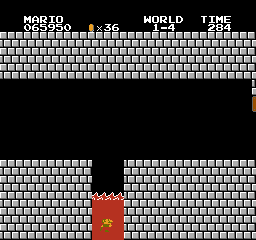

Pipe travel
In SMAS, Mario will face us and flash his signature V-sign as he enters vertical pipes.

Water exits
A block was added directly above the exit pipe in water stages. This prevents Mario from getting stuck in the wall.


Brick physics
In the NES version, Mario bounces back very quickly after breaking a brick block. When Mario jumps and breaks a brick in All-Stars, he is pulled upward for a split second. Unfortunately, this small change wrecks the rhythm of the original game; in All-Stars, instead of rebounding off a brick block without losing speed, when Mario makes a running jump and breaks a brick that is connected to another block, he'll bump into the adjacent block and fall straight down, resulting in a total loss of momentum.
This change affects both Super Mario Bros. and Super Mario Bros.: The Lost Levels, but Super Mario Bros. 3 was spared, thankfully.
World 6-3
The very gray 6-3 was changed to a normal night stage in SMAS.




World 8-3
The brick wall backgrounds were removed in favor of a continuous wall in the background.
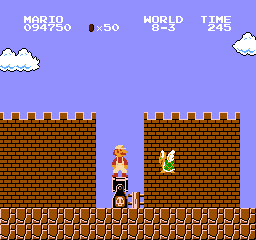

As a result, the multi-coin block at the end is much more visible.


World 8-4
Thunder booms as frequent lightning lights up the windows in the background in the SMAS version.
The water section now uses the normal castle background music instead of switching to the water music. Similar to other water areas, a block was added above the exit pipe.


Princess Toadstool
SMAS's ending is a bit more dramatic. Princess Toadstool is held in a cage, but Mario just jumps right in through the side...


Inside the cage, the redesigned Princess Toadstool wraps her arms around Mario. The game then zooms in on the kiss.


As explained below, the text after "Thank you Mario!" was changed.
Second quest
Right after saving Princess Toadstool, All-Stars starts you in World *1-1 to begin the second quest. In the original version, you are taken back to the title screen, where you can push B to select a world. Unlike the NES version, All-Stars carries over Mario's status, score, and coin total.
SMAS puts a star in front of the world number to denote the second quest.
When you save Princess Toadstool in the second quest, a different message appears.

